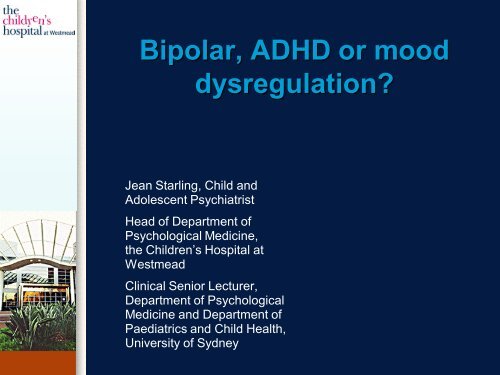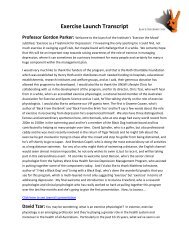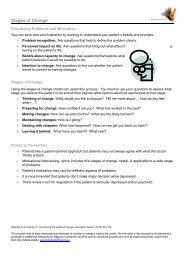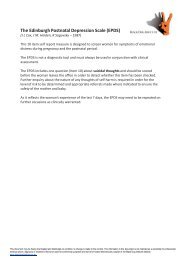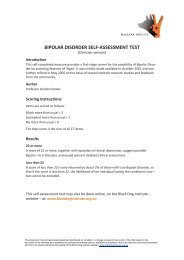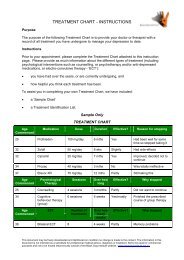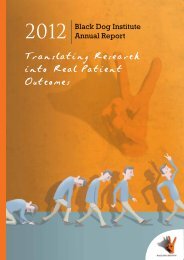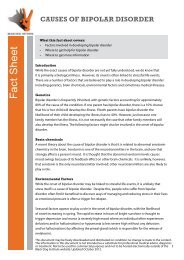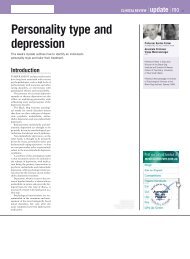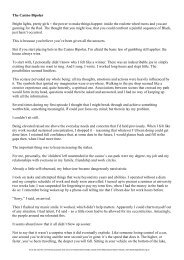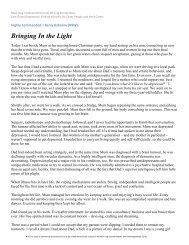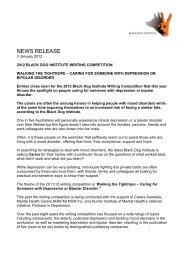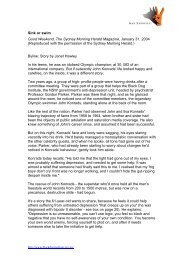Bipolar, ADHD or mood dysregulation? - Black Dog Institute
Bipolar, ADHD or mood dysregulation? - Black Dog Institute
Bipolar, ADHD or mood dysregulation? - Black Dog Institute
You also want an ePaper? Increase the reach of your titles
YUMPU automatically turns print PDFs into web optimized ePapers that Google loves.
<strong>Bipolar</strong>, <strong>ADHD</strong> <strong>or</strong> <strong>mood</strong><br />
Jean Starling, Child and<br />
Adolescent Psychiatrist<br />
Head of Department of<br />
Psychological Medicine,<br />
the Children’s Hospital at<br />
Westmead<br />
<strong>dysregulation</strong>?<br />
Clinical Seni<strong>or</strong> Lecturer,<br />
Department of Psychological<br />
Medicine and Department of<br />
Paediatrics and Child Health,<br />
University of Sydney
Summary of Talk<br />
• Differing views on diagnosing paediatric<br />
bipolar dis<strong>or</strong>der<br />
• Dis<strong>or</strong>ders that can be confused with<br />
paediatric bipolar dis<strong>or</strong>der<br />
• Assessing symptoms in children with<br />
<strong>mood</strong> and behaviour problems
A very brief overview of the<br />
concept of Paediatric <strong>Bipolar</strong><br />
Dis<strong>or</strong>der
Kraepelin on Paediatric <strong>Bipolar</strong> Dis<strong>or</strong>der<br />
“In rare cases the first beginnings can be traced back even<br />
bef<strong>or</strong>e the tenth year…..The greatest frequency of first<br />
attacks falls, however, in the period of development with<br />
its increased emotional excitability between the fifteenth<br />
and the twentieth year”<br />
Only 0.4% of Kraepelin’s adult patients rep<strong>or</strong>ted manic<br />
symptoms pri<strong>or</strong> to the age of ten<br />
1921 translation of Manic-Depressive Insanity and Paranoia,<br />
<strong>or</strong>iginally published 1899
Mid 20 th Century views on Paediatric<br />
<strong>Bipolar</strong> Dis<strong>or</strong>der<br />
• While case studies of apparent pre-pubertal presentation<br />
were rep<strong>or</strong>ted the prevailing view was that bipolar<br />
dis<strong>or</strong>der did not present in children<br />
• Thought that children lacked the developmental capacity<br />
to develop <strong>mood</strong> dis<strong>or</strong>der <strong>or</strong> psychosis<br />
• Part of a lack of awareness of severe mental illness in<br />
children shown by many child health services<br />
• F<strong>or</strong> example, Anthony and Scott (1960) reviewed 28<br />
cases of alleged mania from 1884-1954 and decided that<br />
they were almost all misdiagnosed<br />
• From the 1990s increasing awareness of the possibility<br />
of bipolar dis<strong>or</strong>der symptoms pri<strong>or</strong> to puberty (Faedda<br />
1995)
NIMH Research Roundtable<br />
on Prepubertal <strong>Bipolar</strong> Dis<strong>or</strong>der JAACAP 2001<br />
Panel consisted of 19 experts studying paediatric bipolar dis<strong>or</strong>der (including<br />
Biederman, Birmaher, Carlson, Geller & Kowatch)<br />
• Diagnosis of bipolar dis<strong>or</strong>der in prepubertal children is possible<br />
• Rare f<strong>or</strong> children to meet full DSM-IV diagnostic criteria f<strong>or</strong> bipolar<br />
I <strong>or</strong> II, m<strong>or</strong>e likely in teenagers<br />
• Other children do not meet DSM-IV criteria but are still severely<br />
impaired by symptoms ( behaviour dis<strong>or</strong>der, <strong>mood</strong> instability) –<br />
this group is much larger – 2-4% of the population<br />
• <strong>Bipolar</strong> not otherwise specified (NOS) recommended as a<br />
“w<strong>or</strong>king diagnosis” f<strong>or</strong> the non–DSM-IV group<br />
• Symptoms in the NOS group included aggressiveness, agitation,<br />
explosiveness, irritability, excessive <strong>mood</strong> lability, <strong>ADHD</strong>, anxiety,<br />
oppositional defiant dis<strong>or</strong>der and early onset of substance use<br />
• Not clear what the outcome is f<strong>or</strong> this group – do they go on to<br />
adult bipolar dis<strong>or</strong>der?
The broader pediatric bipolar spectrum<br />
concept<br />
• In summary, current opinion is that “classic” adult mania <strong>or</strong><br />
hypomania is rare in children<br />
• There is then controversy about what is the childhood<br />
equivalent:<br />
1. Need a developmental equivalent of hypomania to make the<br />
diagnosis – considers PBD rare - but acknowledges that in<br />
adolescents episodes can be frequent and mixed states<br />
are common OR<br />
2. Includes an elevated <strong>mood</strong> “equivalent” which may include<br />
irritability, agitation <strong>or</strong> explosiveness and considers some<br />
behaviours, including aggression, oppositional defiant<br />
dis<strong>or</strong>der and <strong>ADHD</strong> as part of the spectrum – BPD m<strong>or</strong>e<br />
common<br />
Both groups agree that children with these symptoms will be<br />
distressed and disabled BUT the diagnosis and treatment<br />
plan will differ
The conservative view: A child and<br />
adolescent <strong>mood</strong> dis<strong>or</strong>der coh<strong>or</strong>t<br />
• Coh<strong>or</strong>t of 9, average age 13.7 (range 10-17), 33%<br />
male<br />
• All had a hist<strong>or</strong>y of hypomania (7/9 interviewed during<br />
an admission f<strong>or</strong> hypomania)<br />
• All had a hist<strong>or</strong>y of delusions (grandiose) and 7/9 had<br />
audit<strong>or</strong>y hallucinations<br />
• All met SCID (DSM-IV based diagnostic interview)<br />
criteria f<strong>or</strong> <strong>Bipolar</strong> I (hypomania <strong>or</strong> mania)<br />
Starling pilot data 2009
A child and adolescent <strong>mood</strong> dis<strong>or</strong>der<br />
coh<strong>or</strong>t: other symptoms<br />
At time of interview:<br />
• Average mania rating scale II (YMRS range I-IV)<br />
• Average DASS anxiety and stress sc<strong>or</strong>e in moderate<br />
clinical range, depression sc<strong>or</strong>e in mild clinical range<br />
• Average CDI (depression scale) not in clinical range<br />
• So even with a group who were unwell enough to be<br />
admitted and who had psychotic features the mania<br />
scale ratings were not extremely high and they had<br />
elevated sc<strong>or</strong>es f<strong>or</strong> depression, stress and anxiety,<br />
suggesting a mixed picture<br />
• Despite the lower YMRS sc<strong>or</strong>es they were impaired on<br />
cognitive testing – IntegNeuro - (w<strong>or</strong>king mem<strong>or</strong>y, verbal<br />
interference and frontal lobe functioning)
The broader view: Child and Adolescent<br />
<strong>Bipolar</strong> Foundation website criteria 1<br />
Several of the following should raise<br />
alarm bells:<br />
- Severe and recurring depression<br />
- Explosive, destructive <strong>or</strong> lengthy rages,<br />
especially after the age of four<br />
- Extreme sadness <strong>or</strong> lack of interest in play<br />
- Severe separation anxiety<br />
- Talk of wanting to die <strong>or</strong> kill themselves <strong>or</strong> others<br />
- Dangerous behavi<strong>or</strong>s, such as trying to jump<br />
from a fast moving car <strong>or</strong> a roof<br />
- Grandiose belief in own abilities that defy the laws<br />
of logic (eg possessing ability to fly)<br />
- Sexualized behaviour unusual f<strong>or</strong> the child’s age
Child and Adolescent <strong>Bipolar</strong> Foundation<br />
website criteria 2<br />
- Impulsive aggression<br />
- Delusional beliefs and hallucinations<br />
- Extreme hostility<br />
- Extreme <strong>or</strong> persistent irritability<br />
- Telling teachers how to teach the class, bossing<br />
adults around<br />
- Creativity that seems driven <strong>or</strong> compulsive<br />
- Excessive involvement in multiple projects<br />
and activities<br />
- Compulsive craving f<strong>or</strong> certain objects <strong>or</strong> foods<br />
- Hearing voices telling them to take harmful action<br />
- Racing thoughts, pressure to keep talking
What are the<br />
disadvantages of<br />
the wider bipolar<br />
diagnosis – <strong>or</strong> what<br />
could be missed?
What dis<strong>or</strong>ders have symptom overlap with<br />
wide spectrum childhood bipolar dis<strong>or</strong>der?<br />
• Attention deficit hyperactivity dis<strong>or</strong>der (in particular<br />
with co-m<strong>or</strong>bid learning <strong>or</strong> behaviour dis<strong>or</strong>der)<br />
• Pervasive developmental dis<strong>or</strong>der (autistic spectrum<br />
dis<strong>or</strong>der), in particular Asperger’s Syndrome and<br />
other high functioning PDDs<br />
• Children with severe affect <strong>dysregulation</strong> (often with a<br />
hist<strong>or</strong>y of trauma)<br />
• Note: these diagnoses do not exclude bipolar<br />
dis<strong>or</strong>der; all are associated with a higher prevalence<br />
of depression and some with a higher prevalence of<br />
psychotic dis<strong>or</strong>der
What are the key differences with these<br />
dis<strong>or</strong>ders?<br />
• <strong>Bipolar</strong> dis<strong>or</strong>der classically has periods of illness and<br />
periods of full (<strong>or</strong> close to full) recovery<br />
• Treatment is often focussed on finding the right medication<br />
to produce remission and prevent relapse<br />
• While psychological and psychosocial treatments are<br />
imp<strong>or</strong>tant a person with bipolar dis<strong>or</strong>der can function well<br />
with no extra assistance between episodes<br />
• In contrast the other dis<strong>or</strong>ders are present at all times,<br />
(though they may w<strong>or</strong>sen with stress) – medication may<br />
help some of the manifestations but the children <strong>or</strong><br />
adolescents will still need supp<strong>or</strong>t from many systems –<br />
family, schools, community services, health services
Different treatment options<br />
• As a generalisation the other dis<strong>or</strong>ders have m<strong>or</strong>e<br />
emphasis placed on:<br />
- managing a child’s chronic difficulties using by<br />
manipulating the environment around the child (to<br />
provide clear, reliable structure with predicable<br />
consequences)<br />
- specifically teaching the child the skills they lack<br />
(academic, social, <strong>mood</strong> regulation)<br />
- educating families and schools<br />
• Plus medication f<strong>or</strong> specific symptoms as warranted
Attention Deficit Hyperactivity Dis<strong>or</strong>der<br />
• One of the most common dis<strong>or</strong>ders in children<br />
• C<strong>or</strong>e symptoms of Inattention, Impulsivity and<br />
Hyperactivity present from a very young age<br />
• Good evidence that stimulant treatment is effective<br />
• Associated with other behavioural dis<strong>or</strong>ders including<br />
oppositional defiant dis<strong>or</strong>der and increased rates of<br />
learning dis<strong>or</strong>ders<br />
• Outcome in adolescence and adult life include total<br />
remission <strong>or</strong> continuing <strong>ADHD</strong> symptoms. At higher<br />
risk of ongoing behaviour dis<strong>or</strong>der, academic<br />
underachievement, relationship breakdowns and<br />
accidental death
Pervasive developmental dis<strong>or</strong>der<br />
(Also called autistic spectrum dis<strong>or</strong>ders)<br />
• Neurodevelopmental conditions – lifelong<br />
• Symptoms include deficits in social interaction,<br />
impaired verbal and nonverbal communication,<br />
restricted and idiosyncratic interests, and<br />
stereotyped behaviours. Increasing awareness of<br />
sens<strong>or</strong>y perceptual abn<strong>or</strong>malities<br />
• Increasing rates of diagnosis (60-120/10,000)<br />
particularly of Asperger’s Syndrome<br />
• High rates of other dis<strong>or</strong>ders including anxiety<br />
(obsessive compulsive dis<strong>or</strong>der), depression in<br />
adolescence, <strong>ADHD</strong> and possibly increased rates<br />
of schizophrenia and bipolar dis<strong>or</strong>der in<br />
adolescence
Autistic Spectrum Dis<strong>or</strong>der<br />
Pervasive<br />
developmental<br />
dis<strong>or</strong>der (autism)<br />
Little <strong>or</strong> no language,<br />
very impaired social<br />
interaction, unusual<br />
behaviours (flapping,<br />
sterotypies, aggression)<br />
PDD-NOS<br />
Autism<br />
Asperger’s Syndrome<br />
(high functioning<br />
autism) Unusual use<br />
of language, po<strong>or</strong><br />
social skills, eccentric<br />
behaviour, can have<br />
highly developed skills<br />
in some areas<br />
Variants<br />
of n<strong>or</strong>mal<br />
Eccentric<br />
n<strong>or</strong>mal<br />
Abilities and behaviours vary with IQ, culture, family and the individual child
Unusual perceptions in autistic<br />
spectrum dis<strong>or</strong>ders<br />
• As part of autism, the following are often seen:<br />
• Dis<strong>or</strong>ganised speech, affective flattening <strong>or</strong> excitement<br />
• Socially unaware behaviour such as talking to<br />
themselves<br />
• Unusual movements including flapping<br />
• Unusual preoccupations and beliefs about the w<strong>or</strong>ld<br />
• Can be watchful and suspicious of others<br />
• Persistence of age inappropriate interests (eg imaginary<br />
friends)<br />
• Sens<strong>or</strong>y perceptual abn<strong>or</strong>malities that may be<br />
misinterpreted as hallucinations
Affect <strong>dysregulation</strong><br />
• Not a DSM-IV diagnosis but a description of symptoms<br />
including unstable <strong>mood</strong> (unhappiness, anxiety, anger)<br />
and difficult behaviours that fluctuate frequently with<br />
apparently min<strong>or</strong> triggers<br />
• M<strong>or</strong>e likely to be seen in children and adolescents with a<br />
hist<strong>or</strong>y of catastrophic <strong>or</strong> repeated severe trauma<br />
• These children are m<strong>or</strong>e likely to be diagnosed with Post<br />
Traumatic Stress Dis<strong>or</strong>der, anxiety dis<strong>or</strong>ders, depression,<br />
<strong>ADHD</strong>, oppositional defiant dis<strong>or</strong>der and conduct dis<strong>or</strong>der<br />
• They are m<strong>or</strong>e likely to live in substitute care (extended<br />
family, foster placements, group homes, refuges)<br />
• High rate of distress and aggression to others in childhood<br />
and self harm in adolescence<br />
• M<strong>or</strong>e likely to develop depression and personality dis<strong>or</strong>der<br />
as adults
Hypomania symptoms<br />
and how they may<br />
present in children –<br />
also considering the<br />
differential diagnosis
Diagnosing Mania in Children<br />
DSM-IV definitions:<br />
• Elated <strong>mood</strong> +/- grandiosity<br />
• Decreased need f<strong>or</strong> sleep<br />
• Flight of ideas <strong>or</strong> racing thoughts<br />
• Po<strong>or</strong> judgement<br />
• Distractibility<br />
• Increased energy, activity and agitation<br />
How would these present in children and younger<br />
adolescents?<br />
Note: always needs to be a change from previous level of<br />
functioning (hard if child very young) plus must cause<br />
impairment
Elated <strong>mood</strong> +/- grandiosity<br />
• Children with elevated <strong>mood</strong> look much the same as<br />
adults – giggly, happy, high, can become irritable if limited<br />
• Grandiose delusions must be interpreted in a<br />
developmental context eg a child may think that they are<br />
going to be a famous act<strong>or</strong> as an adult but would realise<br />
as they grew older this was less likely<br />
• Previous example – dogs as imaginary friends could be<br />
developmentally n<strong>or</strong>mal but being the lead dog is probably<br />
a grandiose delusion (while hearing them talk to you is a<br />
<strong>mood</strong> congruent hallucination)
Decreased need f<strong>or</strong> sleep<br />
• N<strong>or</strong>mal children sleep 8-12 hours/night<br />
• May get less sleep if excited but tired the next day<br />
• <strong>ADHD</strong> children often need less sleep, hard to get<br />
to sleep at night but lots of energy the next day<br />
• Children with autism may have a partially reversed<br />
sleep/wake cycle<br />
• Children with a trauma hist<strong>or</strong>y may have difficulty<br />
getting to sleep and nightmares, but are tired the<br />
next m<strong>or</strong>ning<br />
• In bipolar dis<strong>or</strong>der there is a change in the amount<br />
of sleep required and the time is spent in<br />
purposeful activity, with the child waking full of<br />
energy
Flight of ideas <strong>or</strong> racing thoughts<br />
• N<strong>or</strong>mal children are “hyped up” when excited, then settle<br />
• They can often calm themselves with encouragement<br />
• They are unlikely to rep<strong>or</strong>t subjective racing <strong>or</strong> fear that<br />
their thoughts are out of control<br />
• Children with <strong>ADHD</strong> can move and talk very quickly, but<br />
it is a longstanding pattern<br />
• Children with autism are m<strong>or</strong>e likely to have f<strong>or</strong>mal<br />
thought dis<strong>or</strong>der and behaviour on the catatonia<br />
spectrum, without another diagnosis<br />
• Traumatised children can have rapid <strong>mood</strong> swings from<br />
elated to depressed which appear an over reaction to<br />
their circumstances
Distractibility<br />
• N<strong>or</strong>mal children will become distractible when<br />
stressed <strong>or</strong> excited<br />
• C<strong>or</strong>e feature of <strong>ADHD</strong><br />
• Children with autism will only be interested in<br />
what they see as imp<strong>or</strong>tant, unable to focus<br />
on subjects of no interest at school <strong>or</strong> home.<br />
• Children with anxiety, post traumatic stress<br />
dis<strong>or</strong>der of affect <strong>dysregulation</strong> will have<br />
difficulty focussing because of their high level<br />
of arousal
Increased energy, activity and agitation<br />
• Again a c<strong>or</strong>e symptom of <strong>ADHD</strong><br />
• Agitation should be a change from previous<br />
levels of functioning, even then can be due to a<br />
psychosocial stress <strong>or</strong> another dis<strong>or</strong>der (anxiety,<br />
depression)<br />
• Increased energy should be goal directed in<br />
bipolar dis<strong>or</strong>der, (usually less focussed in<br />
<strong>ADHD</strong>). Goals unrealistic, if not delusional
Disinhibition<br />
• What is considered appropriate varies by age,<br />
developmental level and cultural background<br />
• Needs to be a change from previous level of functioning<br />
• In <strong>Bipolar</strong> Dis<strong>or</strong>der often has a context eg singing in<br />
public because you know you have special abilities<br />
• Disinhibited behaviour also seen in traumatised children<br />
– can be sexually inappropriate <strong>or</strong> over familiar with<br />
strangers
Irritability/Aggression<br />
• Irritability: while it is a DSM-IV criteria f<strong>or</strong> bipolar also<br />
seen in many other dis<strong>or</strong>ders<br />
• Aggression also non-specific - types of aggression<br />
include:<br />
1. Predat<strong>or</strong>y (goal directed, planned, some level of<br />
control) – seen in conduct and other behavioural<br />
dis<strong>or</strong>ders<br />
2. Impulsive/affective (loss of control in front of others,<br />
can damage own property, often rem<strong>or</strong>seful) – seen<br />
in PBD but also in anxiety and <strong>mood</strong> dis<strong>or</strong>ders, also<br />
in stressed children<br />
Again needs to be a change from n<strong>or</strong>mal functioning to be<br />
part of PBD
What happens with co-m<strong>or</strong>bidity?<br />
• Presentations often become m<strong>or</strong>e complex<br />
and difficult to manage<br />
• F<strong>or</strong> example, <strong>ADHD</strong> and <strong>mood</strong> dis<strong>or</strong>der,<br />
traumatised child who develops depression<br />
• The next slides are an example of how<br />
traumatised children and teenagers who<br />
have psychotic symptoms present differently<br />
to those with psychotic symptoms and no<br />
hist<strong>or</strong>y of trauma
A file review of children with trauma and<br />
psychotic symptoms<br />
A file audit of 118<br />
subjects who rep<strong>or</strong>ted<br />
hallucinations and/<strong>or</strong><br />
delusions, mean age<br />
13.7 (CHW)<br />
60 of this these subjects<br />
also rep<strong>or</strong>ted a hist<strong>or</strong>y<br />
of trauma<br />
72% of the subjects who<br />
rep<strong>or</strong>ted trauma were<br />
female<br />
War & Disaster<br />
N=9<br />
Domestic<br />
Violence<br />
N=8<br />
Physical<br />
Abuse<br />
N=13<br />
Trauma<br />
Neglect<br />
N=16<br />
Sexual Abuse<br />
N=34<br />
Death & Loss<br />
N=23<br />
Hainsw<strong>or</strong>th and Starling, presented<br />
at ANZ Child Psychiatry Conf 2009
Symptoms m<strong>or</strong>e commonly seen in<br />
traumatised children with psychotic features<br />
Symptoms Trauma<br />
hist<strong>or</strong>y (N)<br />
No trauma<br />
hist<strong>or</strong>y (N)<br />
χ 2 (p-value)<br />
Hallucinations 95% (57) 84.5% (49) 3.57 (0.05)<br />
Po<strong>or</strong> self care 41.7% (25) 24.1% (14) 4.1 (0.04)<br />
Flashbacks 20% (12) 1.7% (1) 10.05 (0.002)<br />
Aggression 56.7% (34) 29.3% (17) 8.99 (0.003)<br />
Running away 33.3% (20) 13.8% (8) 6.22 (0.01)<br />
Suicide attempt 50% (30) 20.7% (12) 11.05 (0.001)
Symptoms m<strong>or</strong>e commonly seen in sexually<br />
abused children with psychotic features<br />
Symptoms Hist<strong>or</strong>y of Sexual<br />
Abuse (N)<br />
No hist<strong>or</strong>y of<br />
Sexual Abuse<br />
χ 2 (p-value)<br />
Hallucinations 100% (34) 85.7% (72) 5.4 (0.02)<br />
Nightmares 35.3% (12) 13.1% (11) 7.6 (0.006)<br />
Flashbacks 26.5% (9) 4.8% (4) 11.6(0.001)<br />
Drug abuse 29.4% (10) 11.9% (10) 5.3 (0.02)<br />
Alcohol abuse 29.4% (10) 8.3% (7) 8.7 (0.003)<br />
Suicide attempt 61.8% (21) 25% (21) 14.3 (0.00)
The effect of co-m<strong>or</strong>bidity<br />
• Children with pre-existing difficulties<br />
(especially those from a background of<br />
trauma) who develop a <strong>mood</strong> <strong>or</strong> psychotic<br />
dis<strong>or</strong>der are significantly m<strong>or</strong>e likely to<br />
have disturbed behaviour<br />
• This behaviour can make their dis<strong>or</strong>der<br />
harder to manage and put them at greater<br />
risk
Summary<br />
•PBD is a diagnosis of some controversy<br />
•It does exist but can be over diagnosed<br />
•The potential problem with over diagnosis is<br />
unlikely to be labelling a n<strong>or</strong>mal child with a<br />
dis<strong>or</strong>der, but is m<strong>or</strong>e likely to be missing the<br />
best possible treatment f<strong>or</strong> another dis<strong>or</strong>der<br />
•Ruling out BPD in a child does not mean<br />
that they will not develop the diagnosis at a<br />
later age, but our power to predict is currently<br />
po<strong>or</strong>


